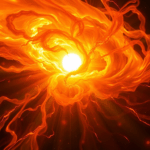Plasma Temperature
For HF operators: Higher temperatures (1M-2M K) and Extreme (above 2M K) often correlate with geomag disturbances that can affect HF propagation and create auroral enhancement on VHF/UHF.
Plasma is the most common state of matter in the universe, making up approximately 99% of visible matter.
No Plasma, no radio. Wait what?
 You know that hams watch the Solar Wind speed all the time and often experience when the solar winds are excessive, (>500Km/sec) that the white noise creeps up and prop dies out.
You know that hams watch the Solar Wind speed all the time and often experience when the solar winds are excessive, (>500Km/sec) that the white noise creeps up and prop dies out.Plasma makes the Ionosphere, you say?
Ionization and Reflection: Solar radiation, specifically UV and X-rays, ionizes the upper atmosphere to create the ionosphere.
These high-energy photons knock electrons free from atoms and molecules, forming a plasma of ions and free electrons.
These ionized layers reflect HF radio waves back to Earth, allowing for long-distance communication (skywave propagation). When the MUF is high enough, radio waves on higher HF bands (like 28 MHz, 24 MHz, 21 MHz) that would otherwise pass through the less-ionized ionosphere and be lost to space are instead reflected back to Earth, enabling long-distance communication (DX).
Higher solar activity (often indicated by hotter plasma and more sunspots) means more intense ionization, which generally leads to better reflection and extends the range of higher HF bands (like 10m, 12m, 15m). See the LIVE table below.
Impact of Solar Plasma Temperature on HF Propagation
The relationship between solar plasma temperature and High Frequency (HF) radio wave propagation is directly mediated by the Earth’s ionosphere. Elevated solar plasma temperatures are indicative of enhanced solar activity, which results in a greater emission of shortwave electromagnetic radiation, particularly in the ultraviolet (UV) and X-ray spectra.
Ionospheric Density and Altitude
Upon impingement with Earth’s upper atmosphere, this increased solar radiation causes a more pronounced photoionization of atmospheric gases. This process generates a higher concentration of free electrons and positive ions, leading to a measurably denser ionosphere. Concurrently, the greater energy input can also lead to the expansion of the ionospheric layers to higher altitudes.
Critical Frequency and Maximum Usable Frequency (MUF)
The heightened electron density within the ionosphere directly influences its refractive properties for radio waves. A denser ionosphere with a greater population of free electrons is capable of reflecting higher radio frequencies. This phenomenon is quantified by the critical frequency, which represents the highest frequency that can be reflected from the ionosphere at vertical incidence. For practical oblique propagation, as utilized in amateur radio (DX), the relevant metric is the Maximum Usable Frequency (MUF). An increase in ionospheric electron density directly correlates with an increase in both the critical frequency and, consequently, the MUF.
Enhanced Reflection for Higher HF Bands
When the MUF surpasses the frequencies of the higher HF bands (e.g., 28 MHz, 24 MHz, 21 MHz), these radio waves, which would otherwise penetrate a less-ionized ionosphere and propagate into space, are instead effectively refracted and reflected back towards Earth. This mechanism is fundamental to facilitating long-distance (DX) communication on these higher frequency bands.
In a Nutshell for the Radio Ham:
Some like it hot?
Just look at that table below, 1 Million Kelvin makes the bands hop! If you see that the tempature is Very Low, like 67,000K deg, then have a coffee.
Ham radio operators do not typically monitor solar plasma temperature as a standalone metric because it’s not directly measured or reported in standard space weather data sources. However, the effects of plasma temperature variations are indirectly reflected in the indices that hams do monitor. When solar plasma temperatures increase dramatically during flares or active region heating, the practical effects that matter to HF propagation are:
- Increased ionizing radiation output (measured as X-ray flux)
- Enhanced solar wind particle density and velocity
- Changes in coronal mass ejection frequency and intensity
These measurable parameters provide actionable information for band planning, while plasma temperature itself remains a background physical driver that’s already captured in the indices ham operators routinely use. The temperature is the “why” behind solar activity, but the radiation and particle outputs are the “what” that affects propagation.
🔴 LIVE HF Band Propagation vs Solar Plasma Temperature
Real-Time Propagation Reference from SolarCdx.com
| Amateur Band | Frequency | Very Low <100K | Low 100K-300K | Normal 300K-1M | High 1M-2M | Extreme >2M K |
|---|---|---|---|---|---|---|
| 160m | 1.8 MHz | Excellent | Excellent | Excellent | Good | Fair* |
| 80m | 3.5 MHz | Excellent | Excellent | Excellent | Excellent | Good* |
| 40m | 7 MHz | Excellent | Excellent | Excellent | Excellent | Excellent |
| 30m | 10 MHz | Excellent | Excellent | Excellent | Excellent | Excellent |
| 20m | 14 MHz | Good | Excellent | Excellent | Excellent | Excellent |
| 17m | 18 MHz | Poor | Fair | Good | Excellent | Excellent |
| 15m | 21 MHz | Closed | Poor | Fair | Excellent | Excellent |
| 12m | 24 MHz | Closed | Closed | Poor | Good | Excellent |
| 10m | 28 MHz | Closed | Closed | Closed | Fair | Excellent |
🔴 Live Propagation Guide:
- White Border: Current plasma temperature zone outlined in white
- Auto-Updates: Table refreshes every 60 seconds with latest SolarCdx.com data
- Band Selection: Use the highlighted column to see which bands are best
- * Caution: Extreme temperatures can cause radio blackouts due to D-layer absorption

